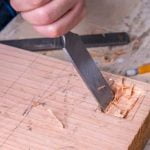Woodworking is a rewarding and creative hobby that allows individuals to craft intricate and functional pieces from wood. However, the key to successful woodworking lies in having the right tools for the job. In this article, we will explore how much a set of woodworking tools cost, highlighting the different types of tools, their quality, factors affecting cost, average cost breakdowns, and budget-friendly options.
Having the appropriate woodworking tools is essential for ensuring precision, efficiency, and safety in any woodworking project. Whether it’s hand tools like chisels and saws, power tools such as drills and sanders, or specialized tools like routers and planers, each one serves a unique purpose in the woodworking process.
In addition to discussing the various types of woodworking tools and their functionality, we’ll also delve into the correlation between quality and price. Understanding how to balance both elements is crucial for making informed decisions when investing in these tools. So let’s dive deeper into the world of woodworking tools and unravel the mysteries behind their costs.
Types of Woodworking Tools
Woodworking tools are essential for any woodworking project, whether you are a beginner or a seasoned professional. To effectively carry out woodworking tasks, it is important to have the right tools for the job. Woodworking tools can generally be classified into three main categories: hand tools, power tools, and specialized tools.
Hand Tools
Hand tools are manual devices that are powered solely by the force of the user’s hands. These include items such as saws, chisels, planes, carving tools, and measuring instruments. Hand tools are essential for precision and detail work in woodworking projects. While they may require physical effort to operate, they offer greater control and accuracy compared to power tools.
Power Tools
Power tools are electric or battery-powered devices that require external power sources to operate. These include items such as drills, sanders, routers, jigsaws, and circular saws. Power tools are designed to make woodworking tasks more efficient and less labor-intensive. They can handle heavy-duty cutting, shaping, and joining of wood materials with ease.
Specialized Tools
Specialized woodworking tools cater to specific tasks or functions within a project. These tools include items such as dovetail jigs, biscuit joiners, pocket hole jigs, and lathe machines. While not always essential for basic woodworking projects, specialized tools offer unique capabilities that can enhance the quality and craftsmanship of your work.
Understanding the purpose and usage of each type of woodworking tool is crucial in determining which ones you need for your specific projects. Whether you prefer the traditional approach with hand tools or opt for the speed and precision of power tools, having a well-rounded collection of woodworking tools will equip you to tackle a wide range of projects efficiently.
Now that we understand the different types of woodworking tools available let’s discuss how much does a set of woodworking cost?
Essential Woodworking Tools
When it comes to woodworking, having the right tools is essential for successfully completing projects. Whether you’re a novice or a seasoned woodworker, having a set of essential tools is crucial to ensure the quality and precision of your work. In this section, we will discuss the must-have woodworking tools for basic projects and their functionality.
Hand Tools
Hand tools are the foundation of any woodworking arsenal. A set of chisels, hand saws, planes, and measuring tools are indispensable for tasks such as shaping, smoothing, and joining wood. These hand tools allow for precise and detailed work that power tools may struggle to achieve.
Power Tools
Power tools offer efficiency and speed in woodworking projects. Some essential power tools include a cordless drill, circular saw, jigsaw, and random orbital sander. These tools are ideal for cutting, drilling, shaping, and sanding wood with ease and precision.
Specialized Tools
Specialized woodworking tools cater to specific tasks such as carving, woodturning, or joinery. While not always essential for basic projects, these tools can elevate your woodworking capabilities to new levels. Depending on the type of project you undertake, specialized tools like carving knives or routers may become necessary.
Understanding the functionality and versatility of each tool is crucial in determining which ones are essential for your specific woodworking needs. As these various types of woodworking tools vary widely in cost based on factors such as brand and quality, it’s important to consider how much does a set of woodworking tools cost against your budget while also obtaining high-quality items that will last for years to come.
Quality vs Price
When it comes to woodworking tools, one of the most important considerations for any woodworker is the balance between quality and price. The quality of your tools can significantly impact the outcome of your projects, as well as your overall experience in the workshop. However, higher quality often comes with a higher price tag. So, how do you determine the right balance between these two factors without breaking the bank?
There are various types of woodworking tools available on the market, each with its own level of quality and price point. Here are some key things to consider when evaluating the relationship between quality and price:
- Brand reputation: Some well-established brands may come with a higher price due to their reputation for superior quality and durability.
- Materials: Tools made from high-quality materials such as hardened steel or solid wood may cost more than those made from cheaper alternatives.
- Features: Tools with advanced features or additional functionalities often come with a higher price tag compared to basic models.
It’s essential to understand that investing in high-quality woodworking tools can save you money in the long run. While budget-friendly options may seem appealing at first, they might not offer the same level of performance and longevity as their higher-priced counterparts.
As a result, you might end up spending more money on replacements or repairs over time. Therefore, it’s worth considering how much does a set of woodworking tools cost in relation to their long-term value and performance.
Factors Affecting Cost
When it comes to woodworking tools, the cost can vary greatly depending on a number of factors. Understanding what influences the price of these tools can help woodworkers make informed decisions when investing in their equipment. Here are some key factors that affect the cost of woodworking tools:
- Brand: The brand of a woodworking tool can have a significant impact on its cost. Well-known and reputable brands often come with a higher price tag due to their established quality and performance.
- Materials: The materials used in the construction of woodworking tools can also influence their cost. Tools made from high-quality materials, such as steel or solid wood handles, tend to be more expensive than those made from cheaper alternatives.
- Features: Woodworking tools with advanced features or added functionalities may be priced higher than their basic counterparts. Additional features such as ergonomic grips, adjustable settings, or built-in safety mechanisms can contribute to an increase in cost.
Finding a balance between cost and quality is essential when considering purchasing woodworking tools. While it may be tempting to opt for the cheapest option available, investing in high-quality tools can ultimately save money in the long run by offering durability and consistent performance.
It’s important for woodworkers to consider these factors when evaluating how much does a set of woodworking tools cost. By understanding the elements that impact pricing, individuals can make informed decisions when selecting the right tools for their projects.
Average Costs of Woodworking Tools
When it comes to woodworking, having the right tools is essential for a successful and enjoyable experience. However, the cost of acquiring these tools can vary widely depending on a number of factors. The average cost of woodworking tools can be determined by the type and quality of the tool, as well as other attributes such as brand and features.
One important thing to consider when estimating the cost of woodworking tools is the type of tool being purchased. Hand tools, power tools, and specialized tools all come with different price ranges. For example, a basic set of hand tools for woodworking might cost anywhere from $100 to $300, while a professional-grade power tool can range from $200 to $800 or more.
In addition to the type of tool, another significant factor that affects the cost is its quality. High-quality woodworking tools are designed to last longer and perform better than their cheaper counterparts.
This means that while they may come with a higher upfront cost, they often provide better value in the long run due to their durability and efficiency. Ultimately, understanding how much a set of woodworking tools costs requires careful consideration of these various factors in order to make an informed decision on which tools are worth investing in.
| Type of Tool | Cost Range |
|---|---|
| Hand Tools | $100 – $300 |
| Power Tools | $200 – $800+ |
Budget-Friendly Options
For those looking to start woodworking on a budget, there are alternative options available that can help save costs without compromising on quality. One option is to consider purchasing second-hand woodworking tools. Many skilled craftsmen often upgrade their equipment, leaving behind gently used tools that can be purchased at a fraction of the cost of new ones. Online marketplaces and local garage sales can be great places to find these second-hand treasures.
Another budget-friendly option is to explore do-it-yourself alternatives for certain woodworking tools. For example, instead of investing in an expensive pocket hole jig, one can create makeshift jigs using scrap wood and screws. While it may require some extra effort and creativity, DIY solutions can be just as effective for basic woodworking projects and can significantly reduce costs.
Lastly, for those who are open to a bit of improvisation, repurposing existing tools for woodworking purposes can also be a cost-effective approach. For instance, using a chisel as a scraper or a table saw fence as a straightedge guide can serve the purpose without having to invest in specific woodworking tools. However, it’s important to note that while budget-friendly options are available, it’s crucial not to compromise on quality, especially when safety is involved.
When considering budget-friendly options for woodworking tools, it’s essential to weigh the trade-offs between cost savings and potential limitations in functionality or durability. Ultimately, the goal is to strike a balance between staying within budget constraints while still acquiring reliable tools that will effectively support your woodworking endeavors. By being resourceful and exploring alternative options, individuals can effectively kickstart their woodworking journey without breaking the bank.
Conclusion
In conclusion, the cost of a set of woodworking tools can vary widely depending on the type, quality, and brand. It is essential to understand the importance of having the right woodworking tools for any project. Hand tools, power tools, and specialized tools each serve a specific purpose and understanding their functionality is crucial in determining which ones are necessary for various woodworking projects.
When considering the cost of woodworking tools, it’s important to weigh quality against price. While high-quality tools may come with a higher price tag, they often provide better performance and durability in the long run. Investing in high-quality tools can ultimately save money by reducing the need for frequent replacements or repairs.
Factors affecting the cost of woodworking tools include brand reputation, materials used, and additional features offered. Despite these variables, there are budget-friendly options available such as second-hand tools or DIY alternatives. It is essential not to compromise on quality when choosing budget-friendly options as investing in reliable tools is crucial for achieving successful woodworking projects. Ultimately, finding a balance between cost and quality is key when considering how much does a set of woodworking tools costs.
Frequently Asked Questions
What Is the Most Used Tool in a Wood Shop?
The most used tool in a wood shop is the table saw. It is a versatile and essential tool for making straight cuts, rips, and crosscuts in various sizes of lumber. Its precision and power make it indispensable for woodworking projects.
What Tools Are Needed to Begin Woodworking?
To begin woodworking, a few basic tools are needed such as a hammer, tape measure, chisels, hand saws, screwdrivers, clamps, a power drill, and a combination square. These tools will allow beginners to tackle simple woodworking projects and develop their skills.
Is Woodworking a Job or a Hobby?
Woodworking can be both a job and a hobby. For some people, it is a profession that they pursue as their primary source of income.
For others, it is a hobby that they enjoy in their spare time to create pieces for themselves or as gifts for others. The level of commitment and purpose determines whether woodworking is seen as a job or hobby.

Hi everyone! I’m a woodworker and blogger, and this is my woodworking blog. In my blog, I share tips and tricks for woodworkers of all skill levels, as well as project ideas that you can try yourself.





